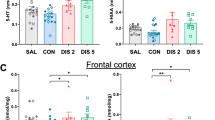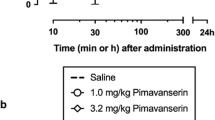Abstract
Examination of HP 184, [N-n-propyl)-N-(3-fluoro-4-pyridinyl)-1H-3-methylindodel-1-amine hydrochloride], in a variety of tests for serotonergic activity revealed some unique properties of this compound. We report here that 100 μM HP 184 enhanced spontaneous release of [3H]serotonin (5-HT) from rat hippocampal slices. This release was independent of the uptake carrier. In vivo assays confirmed that HP 184 (20 mg/kg, i.p.) lacked significant interactions at the norepinephrine (NE) or 5-HT uptake carrier itself. Notably, HP 184 (15 mg/kg, i.p.) reduced drinking behavior in schedule-induced polydipsic (SIP) rats. We previously reported that some selective 5-HT reuptake inhibitors decrease SIP 30–40% after a 14–21 day treatment. In the current study, HP 184 decreased SIP beginning with the first treatment, and this reduction (30%) was maintained for 28 days. We further investigated HP 184 and serotonin metabolite levels. One hour after i.p. administration of 30 mg/kg HP 184, the ratio of whole brain 5-hydroxyindolacetic acid (5-HIAA) to 5-HT was increased, suggesting serotonergic activation. Under these conditions, the brain: plasma ratio of HP 184 was approximately 2∶1, with brain concentrations of 1.6 μg/gram. We speculate that the spontaneous release effects of HP 184 may be responsible for the behavioral effects observed.
Similar content being viewed by others
References
Kongsamut, S., Smith, C. P., and Woods, A. T. 1994. Use of N-(pyridinyl)-1H-indol 1-amines for the preparation of a medicament for the treatment of obsessive compulsive disorders. European Patent No. 94110875.5-.
Smith, C. P., Brougham, L. R., Huger, F. P., Davis, L., Klein, J. T., and Effland, R. C. 1993. N-(n-propyl)-N-(3-fluoro-4-pyridinyl)-1H-3-methylindol-1-amine hydrochloride (HP 184): In vitro spontaneous release of acetylcholine and norepinephrine. Drug. Dev. Res. 30:203–212.
Smith, C. P., Huger, F. P., Petko, W., and Kongsamut, S. 1994. HP 749 enhances calcium-independent release of [3H]norepinephrine from rat cortical slices and synaptosomes. Neurochem. Res. 19:1265–1270.
Smith, C. P., Petko, W. W., Kongsamut, S., Roehr, J. E., Effland, R. C., and Klein, J. T. 1994. Mechanisms for the increase in electrically-stimulated [3H]norepinephrine (NE) release from rat cortical slices by HP 749 [N-(n-propyl)-N-(4-pyridinyl)-1H-indol-1-amine]. Drug Dev. Res. 32:13–18.
Jacobs, B. L. 1976. An animal behavioral model for studying central serotonergic synapses. Life Sci. 19:777–786.
Sternbach, H. 1991. The serotonin syndrome. Am. J. Psychiatry 148:705–713.
Fuller, R. W., Snoody, H. D., and Robertson, D. W. 1987. Mechanisms of efficacy of d-fenfluramine on brain serotonin metabolism in rats: Uptake inhibition versus release. Pharmacol. Biochem. Behav. 30:715–721.
Woods, A., Smith, C., Szewczak, R., Dunn, R. W., Cornfeldt, M., and Corbett, R. 1993. Selective serotonin reuptake inhibitors decrease schedule-induced polydipsia in rats: a potential model for obsessive compulsive disorder. Psychopharmacol. 112:195–198.
Effland, R. C., Klein, J. T., Davis, K. L., and Olsen, G. E. 1990. N-(Pyridinyl)-1H-indol-1-amines U.S. Patent No. 4,970,218.
Zahniser, N. R., Peris, J., and Dwoskin, L. P. 1986. Modulation of neurotransmitter release: An assay for receptor function. Pages 73–81,in Hoffer, B. J. and Zahniser, N. R. (eds.), Chemical and Functional Assays of Receptor Binding, Short Course 1 Syllabus, Society for Neuroscience, Washington D.C.
Passarelli, F., Galzin, A., and Langer, S. Z. 1987. Interaction between neuronal uptake inhibitors and presynaptic serotonin autoreceptors in rat hypothalamic slices: Comparison of K+ and electrical depolarization. J. Pharmacol. exp. Ther. 242:1056–1063.
Limburger, N., Fischer, M. R. G., Wichmann, T., and Starke, K. 1989. Phentolamine blocks presynaptic autoreceptors in rabbit and rat brain cortex. Naunyn-Schmiedeberg’s Arch. Pharmacol. 340: 52–61.
Kongsamut, S., and Nachsen, D. A. 1988. Measurement of the cytosolic sodium ion concentration in rat brain synaptosomes by a fluororescence method. Biochm. Biophys. Acta 940:241–246.
Middelemiss, D. N., and Fozard, J. R. 1983. 8-Hydroxy-2-(di-n-propyl-amino)-tetralin discriminates between subtypes of the 5-HT1 recognition site. Eur. J. Pharmacol. 90:151–153.
Ryan, C. N., Evenden, J. L., and Petterson, M. 1993. Effects of busipirone and ipsapirone on schedule induced polydipsia: comparison with 8-hydroxy-2-(di-n-propylamino) tetralin (8-OH-DPAT) and raclopride. Psychopharmacol. 112:34–44.
Canon, J. G., and Lippa, A. S. 1977. Effects of clozapine, chlorpromazine and diazepam upon adjunctive and schedule controlled behaviors. Pharmacol. Biochem. Behavior 6:581–587.
Sanger, D. J. 1977. Schedule-induced drinking of chlordiazepoxide solutions by rats. Pharmacol. Biochem. Behav. 7:1–6.
Sanger, D. J., and Cornfield-Sumner, P. K. 1987. Schedule-induced drinking and thirst: a pharmacological analysis. Pharmacol. Biochem. Behav. 10:471–474.
Kuribara, H., and Tadokoro, S. 1980. Effects of psychotropic drugs on FI responding and adjunctive drinking in rats. Pharmacol. Biochem. Behav. 13:657–662.
Rowland, N., Antelman, S. M., and Kocan, D. 1981. Elevated water intake in rats treated chronically with amphetamine: drinking in excess of need? Appetite 2:51–66.
Mittleman, G., Jones, G. H., and Robbins, T. W. 1988. Effects of diazepam, FG7142 and Ro-15-1788 on schedule-induced polydipsia and the temporal control of behavior. Psychopharmacol. 94: 103–109.
Snodgrass, S. H., and Allen, J. D. 1987. Effect of dopamine agents on schedule- and deprivation-induced drinking in rats. Pharmacol. Biochem. Behav. 27:463–475.
Falk, J. L. 1971. The nature and determinants of adjunctive behavior. Physiol. Behav. 6:577–588.
Commissiong, J. W. 1985. Monoamine metabolites: Their relationship and lack of relationship to monoaminergic neuronal activity. Biochem. Pharmacol. 34:1127–1131.
Author information
Authors and Affiliations
Rights and permissions
About this article
Cite this article
Smith, C.P., Woods-Kettelberger, A.T., Corbett, R. et al. Serotonergic activity of HP 184: Does spontaneous release have a role?. Neurochem Res 21, 575–583 (1996). https://doi.org/10.1007/BF02527756
Accepted:
Issue Date:
DOI: https://doi.org/10.1007/BF02527756




